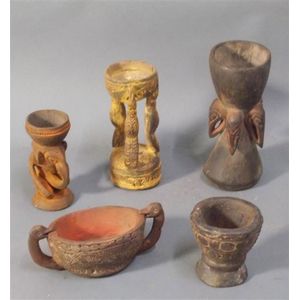Colonial Salt Glaze Gully Traps, Avondale & Unmarked
You must be a subscriber, and be logged in to view price and dealer details.
Subscribe Now to view actual auction price for this item
When you subscribe, you have the option of setting the currency in which to display prices to $Au, $US, $NZ or Stg.
- Salt Glazed - Salt glazing involves throwing salt into the kiln when it is at its highest temperature, usually around 2,300 to 2,400 degrees Fahrenheit (1,260 to 1,320 degrees Celsius). The salt vaporizes and forms a glaze on the surface of the pottery, creating a range of effects depending on how the salt is applied and the firing conditions. This glazing method was first developed in Germany in the 15th century and quickly became popular throughout Europe and North America. It was particularly popular for making stoneware pottery, such as jugs, crocks, and other utilitarian objects.
Salt glazes can produce a range of colors, including gray, brown, blue, and even pink or purple in some cases. The texture of the glaze is typically rough and pebbled, with a matte or satin finish. The process of salt glazing can be unpredictable, with variations in temperature and salt application leading to subtle variations in the finished product.
Salt glazing is still used by potters and ceramic artists although it is less common than it was in the past.
This item has been included into following indexes:
Visually similar items

Five betel Mortars, Sepik-Ramu Region, Papua New Guinea. Length 20 cm

An Edward VII small silver mug, plain form with inscription to front C.E.Mc.C; Samuel Hardy, London, 1904. Height 7 cm. Weight 151.2g.

Two Victorian brass Troy weights, 19th century, each marked Er VIC. probably used on the Victorian Goldfield's. comprising of 300oz weight & 100oz weight. The largest 21 cm high

A collection of four bronze mortars, two pestles and an iron mortar and pestle, Italian, 16th century, the largest bronze mortar, 14 cm high, 16 cm diameter
